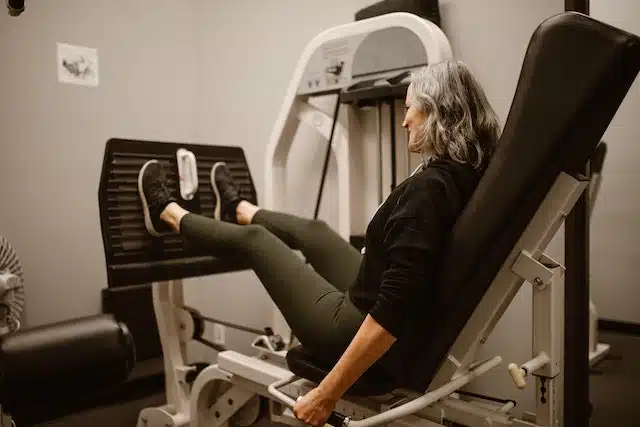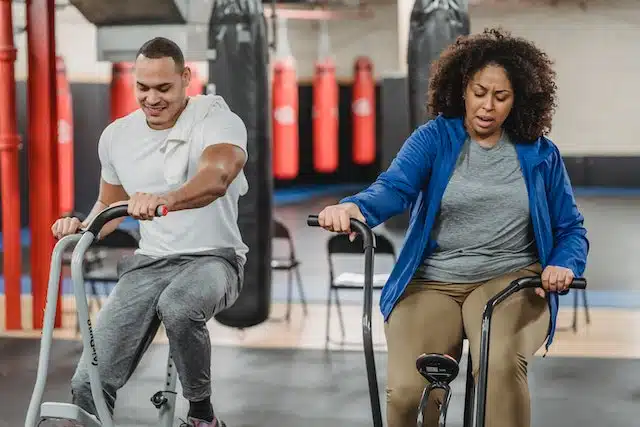How Effective Is High Intensity Interval Training For Over 50s?

In high intensity training (HIIT), short bursts of very intense activity are followed by periods of rest. There is evidence that this type of training is effective for a variety of populations, but is it suitable for middle-aged people?
So lets examine the benefits and drawbacks of high intensity training in middle age. In addition to discussing HIT’s benefits and risks, we will offer some recommendations for those considering it.
High Intensity Interval Training (HIIT) – what is it?
High intensity interval training, or HIIT, is an intense physical workout that alternates short bouts of intense exercise with recovery periods. By using this type of training, both your aerobic and anaerobic fitness can be dramatically improved.
Middle-aged adults can also benefit from a HIIT program. You can burn more calories, build more muscle, and improve your cardiovascular health with this type of training – this is of particular benefit as you reach middle age.
At that age, it is commonly recognized that you need to start becoming more active. Heart health can clearly be improved by HIT training, according to studies.

Can An Over 50 year Old Do High Intensity Interval Training
Yes, a 50-year-old can do high-intensity interval training (HIIT) with proper guidance and modifications based on their individual health condition.
In fact, HIIT programs are suitable for people of all ages and fitness levels as they offer numerous benefits such as improved cardiorespiratory endurance, strength gains, reduced body fat percentage and overall better health.
However, before starting any HIIT program or any exercise regimen it is recommended to get medical clearance from your doctor if you have underlying medical conditions like osteoporosis or history of heart diseases that could be worsened by this type of workout.
Moreover – assuming approval- Beginners may wish to start at their own pace instead of fully joining in intensive sessions immediately but rather gradually elevating the training intensity over time making sure to allow themselves adequate recovery times- helping them properly adapt without causing injury.
When designed appropriately, even more significant results can be accomplished by including low impact exercises which put less stress on joints- supporting those who experience joint pains whether due to an inadequate diet or other physical ailments
Things to consider if you’re thinking about including HIIT as part of your workout regimen.
Before starting your HIIT session, you should warm up properly. As for the intensity of your bursts of activity, you should prioritize quality over quantity.
Listen to your body and take breaks when necessary. Due to its intense nature, HIT can be an incredibly effective way to improve your fitness…but also can be pretty hard on your body.
What are the differences between HIT and other forms of exercise?

High-intensity interval training (HIT) is a type of exercise that differs from the usual moderate workout. As opposed to gently increasing your heart rate, HIT involves bursts of intense activity and then brief periods of rest.
Exercise bikes, rowing machines, etc., can all be used for HIT. Running in short bursts or even weight training can work too.
A high-intensity work period,d followed by a slower recovery period is the key to success. For instance, you might go at a slow pace for 60 seconds, followed by a very fast pace for 20 seconds.
The popularity of HIT has increased in recent years, especially among middle-aged adults. This is likely due to its many potential benefits, such as improved cardiovascular health, increased muscle mass, and reduced body fat.
One study found that middle-aged adults participating in a 12-week HIT program experienced significant improvements in their VO2 max (a measure of cardiovascular fitness) and body composition (including a reduction in body fat percentage).
So Can Middle-Aged Adults Benefit From HIIT?
We experience many changes in our bodies as we age. Even if we aren’t as strong or fast as we used to be in our youth, exercise is still beneficial. The good news is that it’s possible to adapt high intensity training to the needs of older adults.
A study conducted by Harvard University proved that HIT made a significant difference in blood pressure and cholesterol levels in older individuals.
As well as improving bone density, it can also help maintain joint health. Diabetes and obesity risk can also be reduced by HIT. Its quite clear that it has many significant benefits.
HIT may be the right choice for you if you’re hoping to improve your fitness without spending hours at the gym. Get started on a program that is right for you by talking to your doctor or a certified personal trainer.
Does HIT pose any risks to middle-aged adults?
As with all exercise programs, HIT may some risks for middle-aged adults. Among them are:
The cardiovascular system and heart may be put under strain by HIT. Those who already suffer from heart disease or high blood pressure may be at risk.
If you are not used to this type of exercise, HIT can also be tough on joints and muscles. Strains and sprains can result from this.
HIIT can lead to anxiety and other mental health issues if it is too intense and stressful for some.
However it can really be an effective workout for people of any age, but middle-aged adults looking to improve their cardiovascular health and lose weight may find it particularly beneficial.
Begin your workouts slowly and gradually increase the intensity as your body adjusts. Last but not least, listen to your body – if you’re feeling fatigued or sore, take a rest day or two before continuing.
So these are just a few things you should know before you try HIT. Of course before starting any new exercise program, check with your doctor for clearance.
So consider these tips when giving HIIT a try and see if it’s right for you!





